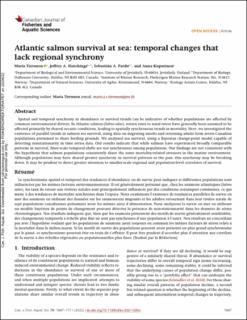| dc.contributor.author | Tirronen, Maria | |
| dc.contributor.author | Hutchings, Jeffrey | |
| dc.contributor.author | Pardo, Sebastián A. | |
| dc.contributor.author | Kuparinen, Anna | |
| dc.date.accessioned | 2022-10-27T08:38:02Z | |
| dc.date.available | 2022-10-27T08:38:02Z | |
| dc.date.created | 2022-10-20T12:39:25Z | |
| dc.date.issued | 2022 | |
| dc.identifier.citation | Canadian Journal of Fisheries and Aquatic Sciences. 2022, 79 (10), 1697-1711. | en_US |
| dc.identifier.issn | 0706-652X | |
| dc.identifier.uri | https://hdl.handle.net/11250/3028571 | |
| dc.description.abstract | Spatial and temporal synchrony in abundance or survival trends can be indicative of whether populations are affected by common environmental drivers. In Atlantic salmon (Salmo salar), return rates to natal rivers have generally been assumed to be affected primarily by shared oceanic conditions, leading to spatially synchronous trends in mortality. Here, we investigated the existence of parallel trends in salmon sea survival, using data on migrating smolts and returning adults from seven Canadian populations presumed to share feeding grounds. We analysed sea survival, using a Bayesian change-point model capable of detecting nonstationarity in time series data. Our results indicate that while salmon have experienced broadly comparable patterns in survival, finer-scale temporal shifts are not synchronous among populations. Our findings are not consistent with the hypothesis that salmon populations consistently share the same mortality-related stressors in the marine environment. Although populations may have shared greater synchrony in survival patterns in the past, this synchrony may be breaking down. It may be prudent to direct greater attention to smaller-scale regional and population-level correlates of survival. | en_US |
| dc.language.iso | eng | en_US |
| dc.title | Atlantic salmon survival at sea: temporal changes that lack regional synchrony | en_US |
| dc.title.alternative | Atlantic salmon survival at sea: temporal changes that lack regional synchrony | en_US |
| dc.type | Peer reviewed | en_US |
| dc.type | Journal article | en_US |
| dc.description.version | publishedVersion | en_US |
| dc.source.pagenumber | 1697-1711 | en_US |
| dc.source.volume | 79 | en_US |
| dc.source.journal | Canadian Journal of Fisheries and Aquatic Sciences | en_US |
| dc.source.issue | 10 | en_US |
| dc.identifier.doi | 10.1139/cjfas-2021-0302 | |
| dc.identifier.cristin | 2063223 | |
| cristin.ispublished | true | |
| cristin.fulltext | original | |
| cristin.qualitycode | 2 | |
